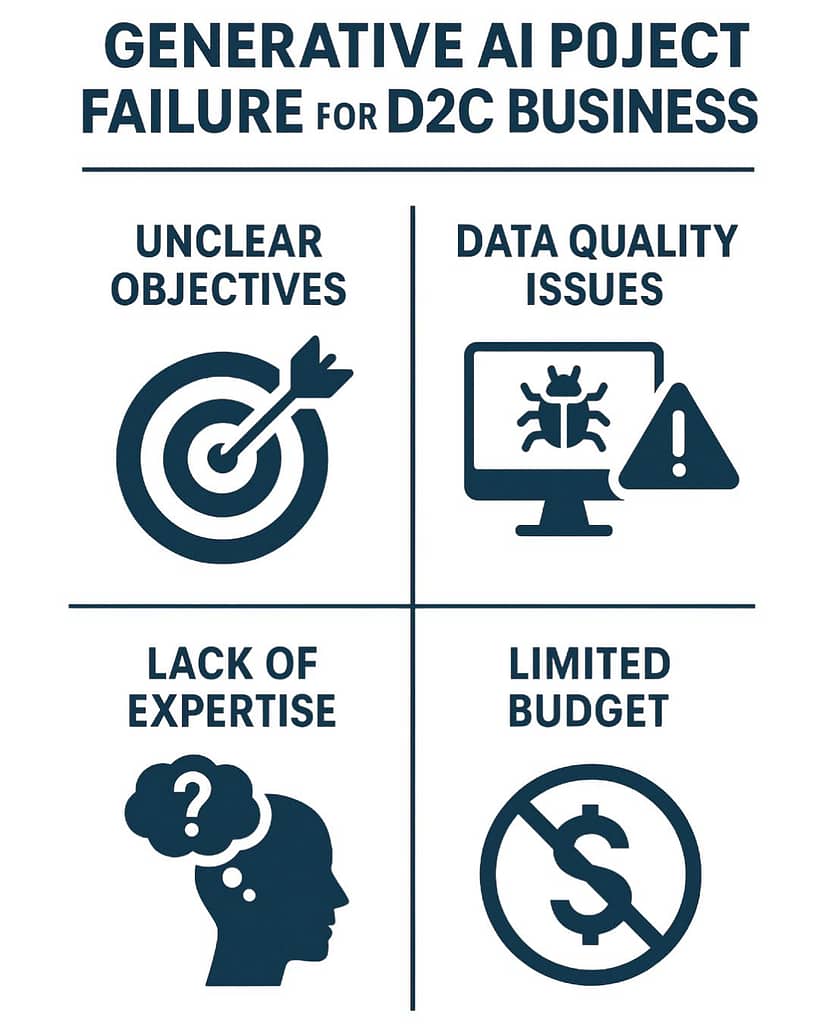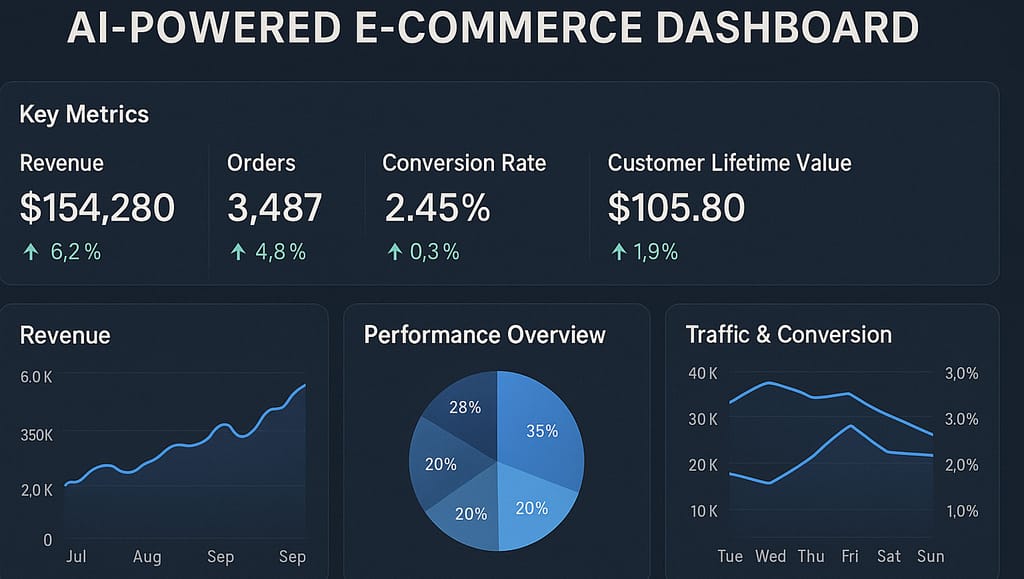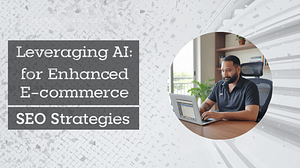Generative AI Project Failure a MIT Bombshell Shock the Startup Ecosystem and here is what the best lessons to Adopt.
Despite a $44 billion investment surge, an MIT study has found that 95% of generative AI projects in business fail to deliver results. For direct-to-consumer (D2C) entrepreneurs, this gap between hype and success holds vital lessons on strategy, adaptation, and sustainable growth. This in-depth guide explains why projects falter, what leading D2C brands do differently, and how to turn AI investments into measurable value.
For D2C entrepreneurs and digital marketers, this isn’t just a cautionary tale it’s a wake-up call about hype, risk, and the urgent need for smarter, more strategic AI adoption. In this comprehensive guide, discover why so many generative AI projects fall short, what separates successful D2C brands from the rest, and get actionable, step-by-step insights to turn costly AI experiments into true value for your organization.

Why The Buzz is Important to Notice ?
Recent headlines have been dominated by AI’s promises—exploding productivity, slashing costs, and new business frontiers. But for every blockbuster generative AI project, nineteen quietly miss the mark. According to MIT’s “The GenAI Divide: State of AI in Business 2025,” only a sliver of corporate deployments create real business impact.
What does this mean for D2C leaders and e-commerce entrepreneurs? In this comprehensive analysis, discover why most generative AI projects are failing, what actually works, and how you can position your D2C brand to win in the next wave of digital transformation
The Hype vs. Reality
Generative AI’s projected global economic impact exceeds $6 trillion by 2030. Yet, MIT’s latest report reveals a painful disconnect between AI’s potential and actual business results, especially for D2C brands
The Investment Boom
- Over $44 billion invested in generative AI startups in H1 2025 alone.
- Fortune 500 companies and major D2C brands rushed to deploy AI-driven tools for marketing, support, and logistics.
Reality Check
- 95% of enterprise generative AI projects (including e-commerce and D2C pilots) fail to realize business value or ROI.
- Most deployments never move beyond flashy pilots; only 5% reach profitable, production-scale integration.
- AI models reliably automate about 30% of office and back-end e-commerce tasks—humans must handle the rest.
“The hype on LinkedIn says everything has changed, but in our operations, nothing fundamental has shifted.” Mid-market COO, MIT GenAI report.
Key Challenges for Generative AI in D2C and E-commerce
MIT researchers highlight fundamental barriers—lack of adaptation, integration gaps, and misaligned priorities—behind generative AI’s high failure rate in D2C.
Poor Integration into Core Workflows
- AI tools, built on generic large language models, often don’t fit the unique flows of D2C operations.
- Brands underestimate the need for deep customization, resulting in fragmented, redundant tools.
Misaligned Investment
- Over 50% of corporate AI spend is on sales and marketing automation, with mission-critical back-end areas (logistics, fulfillment, inventory) neglected.
- Successful D2C brands balance investment: customer-facing AI and operational AI equally.
The Learning Gap
- Organizations lack best practices for onboarding, procedure alignment, and staff training with AI.
- Worker skepticism is high—62% think the tech is “overhyped,” limiting adoption and creative experimentation.
Scalability Barrier
- Most AI pilots stall before moving to production, partly due to brittle integrations and resistance to new workflows.
- Scaling requires both technical and cultural adaptation.
AI Bias and Content Saturation
MIT’s study warns of emerging “AI-to-AI bias”—algorithms preferring AI-generated content, forcing D2C brands to adapt their messaging and creatives for AI ranking engines.
Strategies & Best Practices for D2C Success with AI
The small cohort of thriving AI-first D2C brands share common winning practices: narrow focus, strategic integration, and a relentless data-driven mindset.
Focused Use-Cases, Not General Hype
- Successful startups pick one pain point (ad copy, inventory, or customer service) and engineer tightly around it.
- Narrow focus accelerates learning and ROI.
Data-Quality and Feedback Loops
High-quality, structured data is essential for generative AI to work—D2C winners invest heavily in clean product information, robust customer profiles, and transaction history.
Human-AI Collaboration
- Top brands don’t replace humans but pair AI-driven automation (e.g., chatbots) with skilled customer service reps, maximizing both speed and empathy.
- Successful D2C companies use AI to augment—not replace—staff for tasks like product recommendations and dynamic pricing.
Iterative Experimentation
- Leaders run multiple small pilots, rapidly iterate on failures, and scale what works.
- Proven tip: Assign cross-functional teams (marketing, tech, ops) to own each AI project, ensuring collective buy-in.
Strategic Partnering
Many winning D2C startups partner with larger brands to scale AI solutions, pooling resources, data, and market access

Case Studies: Startups Thriving with AI
Where Fortune 500s stall, lean D2C startups and scale-ups show rapid, focused AI-driven growth.
Copywriting Automation (D2C Startup)
- Problem: Manual ad copy slowed down campaign launches.
- Solution: Integrated a generative AI tool focused exclusively on Facebook and Instagram ad creative.
- Result: Reduced content production time by 70%, with campaign ROI up 25% in 12 months.
Inventory Forecasting (Apparel E-commerce)
- Problem: Frequent stock-outs and overstocking.
- Solution: Deployed generative AI for demand forecasting and automated reordering.
- Result: Stock-outs fell by 40%, and inventory costs dropped by 15%.
Customer Support (Growth-Stage D2C Brand)
- Problem: High ticket response times.
- Solution: AI chatbot handled FAQs, routing complex queries to live agents.
- Result: 36% drop in support costs, 18% increase in CSAT scores.
Step-by-Step Implementation Guide for D2C Brands
A tactical roadmap for D2C brands to safely extract value from generative AI, avoiding the pitfall of failed pilots.

Define Specific Goals
Start with a well-articulated business case For Ex- Reduce cart abandonment by 10% using AI-generated email recommendations.
Audit and Structure Data
Prioritize data hygiene, collecting, and validating product, customer, and transaction data.
Identify Focused Use Cases
- Align AI solution selection to clear business pain points.
- Examples: personalized recommendations, automated product descriptions, predictive inventory.
Build, Test, and Integrate
- Pilot the AI with a small, measurable workflow.
- Integrate tightly with existing backend and frontend systems to avoid siloed AI islands.
- Upskill staff; make AI success a shared responsibility.
Measure, Iterate, Scale
- Regularly review KPIs—conversion rates, cost savings, customer satisfaction.
- Scale what works, rapidly sunset what doesn’t.
Future Trends: How AI Will Change D2C Forever
Generative AI is set to reshape the D2C space—but only for brands willing to adapt, experiment, and invest in the right foundations.
- Increasing AI-to-AI content curation will force product brands to “AI-proof” listings and ad copy for search and recommendation engines.
- Personalized marketing and real-time pricing will see heavy automation, provided brands maintain high data quality.
- Investment will surge in supply chain and fulfillment automation—an underdeveloped yet lucrative aspect for future-ready D2C brands.
- Regulatory scrutiny of AI-driven operations and data privacy will require tighter controls and transparency from D2C operators.
Key Takeaways
- 95% of generative AI projects fail in business—mainly due to poor workflow fit and lack of specialization.
- D2C success demands clear business goals, structured data, focused pilots, and strong internal alignment.
- Human-AI collaboration achieves the best outcomes; don’t aim to “replace” people, but to multiply their impact.
- Startups excel thanks to agility and laser focus—D2C brands can win by adopting a similar mindset.
- The next AI “winners” in D2C will rigorously measure impact, optimize for both customer experience and operational efficiency, and stay ahead of regulatory shifts.
As the dust settles on the generative AI hype cycle, the winners in D2C will be those who combine strategic focus, high-quality data, and smart human-AI collaboration. The opportunity is real—but only for those willing to move past buzzwords and put in the work.
Ready to future-proof your D2C brand?
Explore more actionable guides, advanced D2C technology playbooks, and exclusive case studies at D2C Today. Share your experiences or questions in the comments and join the conversation on shaping the next wave of e-commerce innovation!
Frequently Asked Questions (FAQ)
Generative AI Project Failure in e-commerce?
Because they aren’t customized to the business’s unique workflows or lack clean, structured data, leading to poor integration and little measurable value.
What’s the first step for a D2C brand starting with AI?
Audit business goals and data quality;—define a specific use case (e.g., personalized product recommendations) rather than adopting generic AI tools.
How can a D2C company avoid the AI “hype trap”?
Focus on incremental, measurable pilots, involve cross-functional teams, and balance automation with human expertise at every stage.
Does AI help more in marketing or operations for D2C?
AI’s biggest current value in D2C is in marketing and customer experience, but operational applications (like supply chain forecasting) are rapidly growing.
What are the risks of using generative AI for D2C brands?
Brand erosion from generic content, AI bias in product visibility, privacy compliance, and organizational resistance to workflow changes.
Are smaller D2C startups better positioned for AI success?
Yes; smaller teams with focused goals often move faster, learn quicker, and scale successful pilots more efficiently than large, slow-moving enterprises.
How can D2C brands measure ROI from AI initiatives?
By setting clear KPIs—conversion rates, repeat customer rate, fulfillment cost per order, etc.—and tracking improvements after AI deployment.
What’s the future of generative AI in D2C retail?
Hyper-personalization, AI-driven customer journeys, smarter automation of supply chains, and tighter integrations with marketing platforms.







